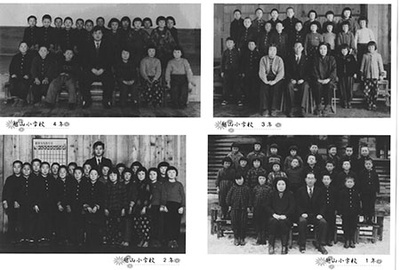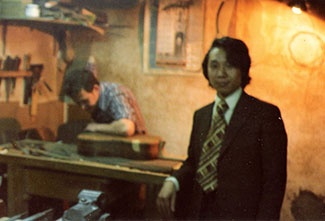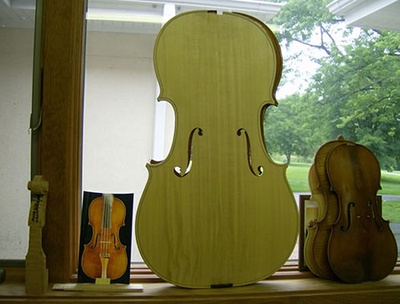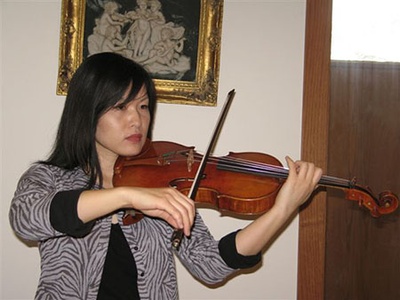The first time I heard of Tetsuo Matsuda was in 1992 in Tokyo. I was a violin student at a music conservatory in Tokyo and had just discovered and become infatuated by the dark rich sound of the viola. This is an often overlooked instrument of the string family. The viola is larger than a violin with a different set of strings but still played on the shoulder.
A Japanese professor from the Julliard Conservatory in New York City was visiting Japan and he had just given me a viola lesson. After the lesson, he recommended that I purchase a viola. Good quality, reasonably priced contemporary violas were hard to find in Japan. He suggested that I obtain one, at a very good price, from a Japanese maker who was living in Chicago, Tetsuo Matsuda. I had just started playing the viola and wanted to learn the instrument well before purchasing one. The following year, I came to America to study at the Peabody Conservatory. After graduating, I moved to Chicago to perform with the Civic Orchestra of Chicago.
Over the years, I had been wondering about Matsuda and his violas. One day, I was at a Japanese festival in Chicago and I saw a man with a name tag "Matsuda" sitting at a table volunteering. I immediately went up and asked him, "Are you the famous instrument maker?" I introduced myself and asked him if I could try his instruments. He invited me to his studio few weeks later to show me his newly built viola and a violin. His beautiful studio in the country was filled with the fresh smell of wood and had a serene atmosphere. I watched him work and was surprised to observe how strenuous it was to curve wooden pieces into instruments. He showed me aged pieces of spruce, for the front of the instrument, and maple for the back. Those fine antique imported materials could cost up to few hundred dollars per piece." How do you determine which wooden piece will be a part of a good sounding instrument?", I asked. He picked up a front panel and started tapping his finger all the way around the edge of it. He put his ear up close to the wood to hear the sound resonate. " I can feel and hear it with my hands, every instrument is a new discovery."
Matsuda's motto in string instrument building is "clear sound, powerful sound and quick response." "I am very happy when an instrument fulfills both the needs of the performer and also my taste. The sound of an instrument has to project because of the increasing size of modern concert halls. My philosophy developed from performer's point of view. I would like my instruments to resonate and project from the day I finish building. I also would like my instruments to directly convey the performer’s emotion."
Matsuda's deep understanding of a performer’s needs goes back to his earlier years. He was born right after the war in Akita, a rural and farming region. In his twenties, he went to Tokyo to look for better opportunities and lived with his brother. He worked at construction among other random jobs to make a living. The landlord of the apartment where they lived owned a guitar shop, and Matsuda started to work as an apprentice guitar maker. His boss also made violins, but it was a difficult business because of the lack of demand in contemporary violins at that time. Matsuda loved the sound of the violin. His brother had record player and they enjoyed listening to classical music. "I learned everything I could in guitar and violin making from my boss and started dreaming of making living by only making violins one day." In spite of long work hours building instruments, he took guitar and violin lessons over the years. He even studied with a well-known violinist in a major orchestra, spending one fifth of his salary on a single lesson. "He used to agonize listening to me struggling to play and told me, 'what is the use of trying so hard, Mr. Matsuda? You will not be able to become professional player anyway.' But I wanted to know what it required to produce a good sound in order to understand instruments better."
His boss was pleased with Matsuda’s dedication and hard work and invited him for a group trip to Spain to observe guitar shops. Matsuda was fascinated by his first overseas experience and professional exposure. It was after the trip that he started to dream about studying at a violin school in Italy. Cremona, Italy had produced some of the most famous violinmakers in history, such as Stradivari and Guarneri. There were not many Italian-trained violinmakers in Japan then. Matsuda was fascinated when an exhibition of contemporary top violinmakers came to Tokyo. He spent all of his savings and borrowed money to purchase a fine Italian violin from the collection. "I wanted to own it so that I could learn from it. One day, I wanted to be able to make violins at that international level. I was desperate to rise to that level in craftsmanship in order to meet up with the high expectations of professional musicians".
Matsuda was accepted to a violin making school in Cremora. His brother, a famous western sculptor had a student studying art in Italy. This student eventually assisted Matsuda in his transition to Europe. Before he left for Italy, he met his wife through his boss as she was in a guitar ensemble and an amateur violinist. She paid off the debt on Matsuda's violin and moved to Italy with him. Over the years, she supported Matsuda's craftsmanship and passion. With his limited Italian language skills, he managed to rent a room with a leaky ceiling and no bath. " I tried so hard using hand gestures trying to rent a place." He studied very hard at school and rushed back to his tiny apartment to build his own violins so that he could make living. His wife gave birth to his son there to whom he gave an Italian name "Guiseppe", named after Guarneri. "I gradually started to realize how little I knew about violin making." He already had years of experience crafting instruments, and in that sense he was above any other students. "But I realized I could not keep making copies of famous makers and I had to establish my own style." He researched patterns, the arch of the violin, the quality of the material, the thickness of wooden pieces, how the f holes were shaped and the quality of varnish. He went through much experimentation, analyzing the differences between his violins and the master makers. Often times he had someone play for him to compare and contrast the instruments. His struggle and research intensified and he had dreams that he was being left behind by the other students. He improved his technique by taking a newly-built violin apart and replacing different parts. His hard work was acknowledged by a fifth place award at the Wieniawski Competition in 1981 and also a second place award at the Cremona Competition in 1982. When he graduated, a friend from the school who was working at a violin shop in Chicago invited him to interview. Chicago had a vibrant classical music scene, attracting famous musicians from all over the world. Matsuda became well known by winning a gold medal at the Violin Society of America in 1984 and he became independent from the shop in 1993. Making a living by only building instruments is rare, since most of the makers still have to do repairs and sales of the violins to make enough income. His instruments are valued many times more now and famous string players from all over the world commission violins, violas and cellos from him. He builds at fast pace about twenty instruments per year and travels around the world to present his instruments at various music festivals and conventions. He also served as a juror at the Wieniawski Competition to present his expertise and to judge professional violinmakers.
As I tried his viola, I was amazed by its power and the clarity of the sound just as he states in his motto. The viola was designed after his original pattern and had very small round shoulders. It was such a relief to be able to glide my hand up along the finger board easily because of his design and I was extremely amazed by its quick response on every string, which is a rare quality to find in a contemporary viola. An instrument matures like fine liquor. It takes fine quality material and many processes before it has been aged properly. It also needs to be played carefully by a musician who can sense its potential and can develop the sound to its maximum quality. Each instrument has its own personality and it will turn out sounding differently, depending on the way it is played. Matsuda keeps a catalog of all of his instruments. He looked through those photos and said, "I am still experimenting and learning from each instrument I build. I feel fulfilled because I can be creative with my work. I try my best at every instrument because I do not want people hundreds of years from now to consider my work mediocre.” As there is bigger market in contemporary violas than the violins, his violas are also in huge demand. "I love building violas. They resemble to human voices in their quality. I still remember how happy I felt when a musician told me 'this is the sound that I have been looking for.' Choosing and buying an instrument is like a finding a spouse for life. When you find the right one, you have to hang on to it and never let it go." As I was leaving his studio, I asked him, "Have you considered moving back to Japan?" He replied, "I will stay here as long as I can keep building instruments."
Matsuda continues to work in his Chicago area studio. http://matsudaviolin.com/
More Images: Nikkei Album >> The Clear Sounds of Tetsuo Matsuda, Violin Maker
* This article was originally publised in the Voices of Chicago by the Chicago Japanese American Historical Society.
© 2009 Chicago Japanese American Historical Society









